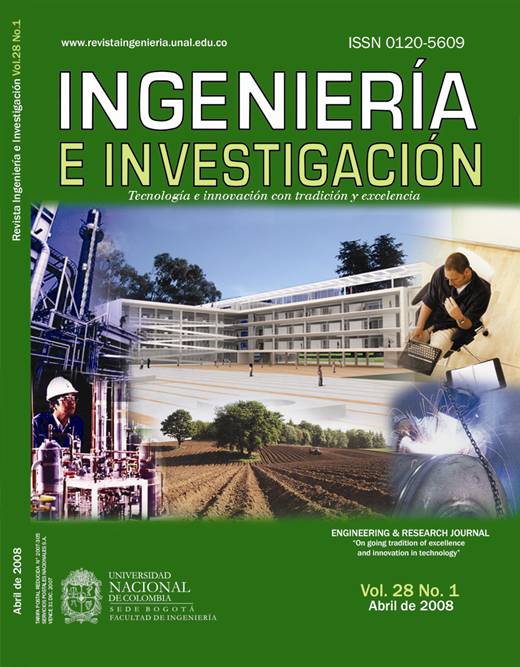Analysing the Diana Turbay CAMI emergency and hospitalisation processes using an Arena 10.0 simulation model for optimal human resource distribution
Análisis del proceso de urgencias y hospitalización del CAMI Diana Turbay a través de un modelo de simulación con Arena 10.0 para la distribución óptima del recurso humano
DOI:
https://doi.org/10.15446/ing.investig.v28n1.14880Keywords:
simulation, resource allocation, waiting line (queuing), waiting time, emergency and hospitalisation area, process optimisation (en)simulación, asignación de recursos, líneas de espera, tiempos de espera, área de urgencias y hospitalización, optimización de procesos (es)
Downloads
This document presents a simulation model describing the current emergency and hospitalisation procedure for the Diana Turbay Immediate Medical Attention Centre (CAMI), a first level health-providing entity, being a dependency of the state Rafael Uribe Uribe hospital (a social entity) in Bogotá (Colombia). A summary of the study was made as well as an overall record of activities being carried out in current attention in the emergency and hospitalisation area and proposals for improving conditions for attending patients and helping to a optimise the institution’s resources in the aforementioned area. The foregoing was used for contrasting waiting times, the number of people queuing and how personnel were being used, aimed at structuring the triage procedure presented by the Rafael Uribe Uribe hospital’s Public Management and Self-control office as they wanted to implement such model within the framework of CAMI’s Remodeling and Extension project. Arena 10.0 simulation software was thus used for helping to measure the impact of such decisions on an organisation before implementing them; different scenarios were thus designed for evaluating the feasibility of reducing waiting times and the number of people queuing, different alternatives being tested regarding timetables and the availability of back-up resources, thereby revealing patients’ different attention and waiting times.
Este documento presenta un modelo de simulación que describe el procedimiento actual de Atención del Área de Urgencias y Hospitalización del Centro de Atención Médica Inmediata (CAMI) DIANA TURBAY, Entidad Prestadora de Salud de Primer Nivel de carácter oficial en la ciudad de Bogotá. En el proceso se elaboró una síntesis de estudio y registro global de las actividades en las condiciones actuales de atención en el área de Urgencias y Hospitalización, así como propuestas que permitieran mejorar las condiciones de atención a los pacientes y que ayudarán a optimizar los recursos con los que dispone la institución en el área mencionada. Lo anterior se obtuvo contrastando los tiempos de espera, personas en cola y utilización del personal, con la propuesta de estructuración del procedimiento del triage presentado por la oficina de Gestión Pública y Autocontrol del Hospital Rafael Uribe Uribe y cuyo procedimiento se desea implementar en el marco del proyecto de remodelación y ampliación del CAMI. También se ensayan diferentes escenarios para evaluar la factibilidad en la reducción de tiempos de espera y número de personas en cola, probando diferentes alternativas de horarios y disposición de recursos de apoyo, con lo cual se muestra una reducción sustancial en los tiempos de atención y de espera de los pacientes.
References
Baesler, F., Jahnsen, H., DaCosta, M. The use of simulation and design of experiments for estimating
maximum capacity in an emergency room. Proceedings of the 2003 Winter Simulation Conference., 2003, pp. 1903-1906.
Baesler, F., Sepúlveda, J., García, R., Rodríguez, M., El uso de la simulación en el análisis del flujo de pacientes en sistemas de salud. Universidad del BioBio, Chile, 2001.
Centeno, M., Giachetti, R. and Linn, R., A Simulation –ILP Based Tool for Scheduling ER Staff., Proceedings of the 2003 Winter Simulation Conference.,2003, pp. 1930-1938.
Centeno, M. García, L., DeCairo, N., and Rivera, C., Reducing time in an emergency room via a fast-. track.,
Proceedings of the 1995. Winter Simulation Conference., 1995, pp. 1048-1053.
Evans, G., Evans, T., and Unger, E., A simulation model for evaluating personnel schedules in a hospital emergency department., Proceedings of the 1996. Winter Simulation Conference., 1996. DOI: https://doi.org/10.1145/256562.256933
Kahl, M. Fundamentos de epidemiología. Ediciones Díaz de Santos S. A., Medellín,1990.
Kelton, D., Simulation with Arena., Mc Graw Hill, Third Edition, New York, 2004.
Kumar A., Kapur, R., Discrete Simulation Application-Scheduling Staff for the Emergency Room., Proceedings of the 1989 Winter Simulation Conference., 1989, pp. 1112-1117. DOI: https://doi.org/10.1145/76738.76880
Lowery, J., Introduction to Simulation in Health Care. Proceedings of the 1996 Winter Simulation Conference., 1996, pp. 78-84. DOI: https://doi.org/10.1145/256562.256578
Ministerio de Protección Social., Resolución 5162 Artículo 10 de 1994
Rossetti, M., Trzcinski, G., and. Syverud, S.A., Emergency Department Simulation and Determination of Optimal Attending Physician Staffing Schedules., Proceedings of the 1999 Winter Simulation Conference., 1999, pp. 1532-1539. DOI: https://doi.org/10.1145/324898.325315
Ruchonen, T., Neittaanmäki, P., Simulation Model for Improving the Operation of the Emergency Department of Special Health Care., Proceedings of the 2006 Winter Simulation Conference., 2006, pp. 453-458. DOI: https://doi.org/10.1109/WSC.2006.323115
How to Cite
APA
ACM
ACS
ABNT
Chicago
Harvard
IEEE
MLA
Turabian
Vancouver
Download Citation
CrossRef Cited-by
1. Oscar Barros, Richard Weber, Carlos Reveco. (2021). Demand analysis and capacity management for hospital emergencies using advanced forecasting models and stochastic simulation. Operations Research Perspectives, 8, p.100208. https://doi.org/10.1016/j.orp.2021.100208.
Dimensions
PlumX
Article abstract page views
Downloads
License
Copyright (c) 2008 Liliana Maria Pantoja Rojas, Luís Antonio Garavito Herrera

This work is licensed under a Creative Commons Attribution 4.0 International License.
The authors or holders of the copyright for each article hereby confer exclusive, limited and free authorization on the Universidad Nacional de Colombia's journal Ingeniería e Investigación concerning the aforementioned article which, once it has been evaluated and approved, will be submitted for publication, in line with the following items:
1. The version which has been corrected according to the evaluators' suggestions will be remitted and it will be made clear whether the aforementioned article is an unedited document regarding which the rights to be authorized are held and total responsibility will be assumed by the authors for the content of the work being submitted to Ingeniería e Investigación, the Universidad Nacional de Colombia and third-parties;
2. The authorization conferred on the journal will come into force from the date on which it is included in the respective volume and issue of Ingeniería e Investigación in the Open Journal Systems and on the journal's main page (https://revistas.unal.edu.co/index.php/ingeinv), as well as in different databases and indices in which the publication is indexed;
3. The authors authorize the Universidad Nacional de Colombia's journal Ingeniería e Investigación to publish the document in whatever required format (printed, digital, electronic or whatsoever known or yet to be discovered form) and authorize Ingeniería e Investigación to include the work in any indices and/or search engines deemed necessary for promoting its diffusion;
4. The authors accept that such authorization is given free of charge and they, therefore, waive any right to receive remuneration from the publication, distribution, public communication and any use whatsoever referred to in the terms of this authorization.



























